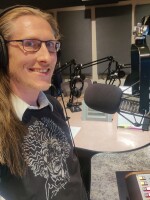An average three New Mexicans die every day from overdose, according to the Legislative Finance Committee. As millions in opioid settlement funds come into the city of Albuquerque and Bernalillo County, officials are seeking input on how to spend them.
In the first of several meetings Tuesday, community leaders made it clear that change needs to happen fast.
When Sindy Bolaños-Sacoman, a consultant working with local government, started the meeting, she asked how many people had been personally affected by the opioid crisis.
Almost every single member of the nearly 40 person audience raised their hands.
Substance use treatment providers, government workers, loved ones of those who died because of opioids, and concerned community members all attended the town hall-style meeting.
Balaños-Sacoman asked questions to spur ideas, and the audience took it from there.
They called for more detox capacity – both more beds at current facilities and new centers to be opened – coordination among treatment providers, an online portal to find available resources, and more affordable or free housing.
Winter Torres, founder and CEO of New Mexico Addiction Prevention and Diversion, argued permanent secure housing shouldn’t require sobriety.
“In this situation, we're going to have folks that are just going to churn. They're going to get better, and they're going to get sick again, and we need to have a place for them to be safe,” she said.
Yolanda Montoya-Cordova, a lifetime resident of the South Valley and former Albuquerque Public Schools board president, brought up the importance of forgiving relapse. For some people, she says, it is bound to happen before recovery sticks.
“Our employers need to understand that. Our schools need to understand that, and our community needs to be ready for that,” she said.
David Burke with Serenity Mesa Youth Recovery Center argued for expanded harm reduction efforts — a practice of minimizing the amount of harm done when people use drugs. The idea is to keep them alive and healthy as possible, so they can eventually make it into recovery.
“It can't just be about sobriety. It doesn't work like that anymore, especially with fentanyl" he said “Fentanyl has changed the game completely.”
Dr. Anjali Taneja, executive director of Casa de Salud, a harm reduction clinic and medical provider in the South Valley, suggested changing the law to allow for overdose prevention centers, also known as “safe injection sites,” where people can go to use drugs under the supervision of staff.
“We need the ability to save lives in this way. People are going to use drugs. Let's stem the crisis by helping to stop them from dying and caring about them as individuals,” she said.
Globally, not a single person has died at an overdose prevention center, according to the National Institutes of Health. Studies have shown they reduce crime and public drug use.
But Burke said the stigma around addiction is so strong, the centers would be a hard sell to the general public.
“There's already a stigma in New Mexico,” he said. “I can walk into a politician's office in Santa Fe with a suit and tie and they think I'm great. I walk in there and have all my tattoos, and I say, I'm in recovery. You get treated differently. It's just how it works”
Commissioner Steven Michael Quezada agreed.
He said when he walked into the meeting earlier that night he was stopped by an elderly woman. He said she complained the county was spending money on people who use drugs, rather than pulling weeds in the parking lot of the community center.
But he said New Mexico should lead the way in out-of-the-box solutions if there is evidence to show they work.
“I think sometimes decision makers have to look past that constituent stigma and do the right thing,” Quezada said. “I'm interested in looking at what that data looks like, and the successes of that. Because nobody's figured this out.”
There will be four more town hall-style meetings where people can provide input.
The next meeting will be on July 17 from 5:30-7:30 p.m. at the Raymond G. Sanchez Community Center, 9800 4th St. NW, Albuquerque, NM 87114
Support for this coverage comes from the W.K. Kellogg Foundation.


